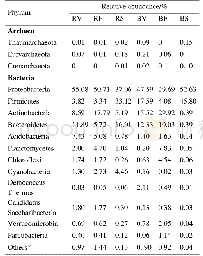《Table 1 Details of rhizosphere soil samples and occurrence of actinomycetes》
 提示:宽带有限、当前游客访问压缩模式
提示:宽带有限、当前游客访问压缩模式
本系列图表出处文件名:随高清版一同展现
《Screening of Actinomycetes from Medicinal Plant Rhizosphere Soils for Industrial Enzymes and Antimicrobial Activity》
Actinobacteria are known to produce various kinds of compounds that are of great interest in many biotechnological applications.The search for new active metabolites(i.e.,antibiotics and enzymes)is still in demand especially for the research community in industry and pharmaceutical area.Actinobacteria are an important source of these useful biomolecules and thus are the focus of the present study.In this study,seven rhizosphere soil samples of the following plants:C.sinensis,P.mirifica,A.comosus,E.scaber,O.grandiflorus,J.multifida and S.siamea,were used as the substrates for screening and isolation of the rhizo-actinomycetes.p H of the soil samples was measured and they were varied ranging from 5.7-7.4(Table 1).As shown in Table 1,a total of 176 strains of actinomycetes were isolated in which the highest number of the actinomycete strains was obtained from P.mirifica.C.sinensis and A.comosus were also good sources for isolating the actinomycetes.However,only a few strains could be isolated from E.scaber,O.grandiflorus,J.multifida and S.siamea,suggesting that the presence of the actinobacteria in these plants were rare(Table 1).Rhizosphere soil was defined as the specific region of contact between soil particles and plant roots(Dessaux et al.,2016).This rhizosphere zone was dynamic and consisted of many terrestrial microbes.It had been suggested that,within the rhizosphere area,a diverse of biochemical activities occurred mainly influenced by plantmicrobe interactions.To date,only a few studies were comprehensive describing a symbiosis between plants and microbes(Coombs and Franco,2003;Khamna et al.,2009;Verma et al.,2009).There is thus an urgent need to explore the microbiome associated with the plant host.The present study albeit preliminary revealed a difference of actinomycete community among the seven rhizosphere soil samples.These actinobacteria were subsequently subcultured to obtain the pure cultures and characterized for their cells and colony morphologies.All the isolates obtained were filamentous,spore-forming and gram-positive bacteria(Fig.1).The colony appearance was also distinct showing the features of actinobacteria(i.e.,tough,leathery,colorful and filamentous)in which the aerial and substrate mycelia were presented(Fig.1).Besides,based on colouration,yellow and grey pigmented colonies were abundant accounting for 44.51%and30.64%,respectively.Other pigmented appearances were also detected as the followings:black(10.98%),white(10.96%),brown(8.67%)and orange(0.58%)(Fig.2) .This pigmented characteristics of the actinomycetes were of great importance because of their possible using in taxonomic identification and their valuables using in biotechnological industry(Conn and Conn,1941;Ramesh and Mathivanan,2009;Kumar et al.,2012).
| 图表编号 | XD0014155800 严禁用于非法目的 |
|---|---|
| 绘制时间 | 2018.09.25 |
| 作者 | Lukcha Vililuk、Tanaporn Wongkuan、Supalak Yacharone、Ekachai Chukeatirote |
| 绘制单位 | School of Science, Mae Fah Luang University、School of Science, Mae Fah Luang University、School of Science, Mae Fah Luang University、School of Science, Mae Fah Luang University |
| 更多格式 | 高清、无水印(增值服务) |
查看“Table 1 Details of rhizosphere soil samples and occurrence of actinomycetes”的人还看了
-

- Table 1.Chemical characteristics of rhizosphere and bulk soils associated with L.ruthenicum in the three growth stages
-

- Table 3.Relative abundances of microbial phyla in rhizosphere and bulk soils at three growth stages.





